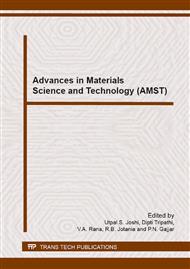p.94
p.98
p.102
p.107
p.111
p.116
p.121
p.125
p.129
Chemical Bath Deposition of Lead Sulphide (PbS) Thin Film and their Characterization
Abstract:
Thin film deposition of PbS is conveniently carried out by chemical reactions of lead acetate with thiourea at room temperature. Energy dispersive analysis of X-ray (EDAX), X-ray diffraction (XRD), selected area electron diffraction patterns (SAED), UV-Vis-NIR spectrophotometer, Scanning Electron Microscopy (SEM), Atomic force microscopy (AFM), Photoluminescence (PL) and Raman spectroscopy techniques are used for characterizing thin films. EDAX spectra shows that no impurity is present and XRD pattern indicates face centered cubic structure of PbS thin films. The average crystallite size obtained using XRD is about 15nm calculated using Scherrer’s formula and that determined from Hall-Williamson plot was found to be 18nm. SAED patterns indicate that the deposited PbS thin films are polycrystalline in nature. Blue shift due to quantum confinement was seen from the UV-Vis-NIR absorption spectra of thin film in comparison with bulk PbS. The Photoluminescence spectra obtained for thin film with different excitation sources shows sharp emission peaks at 395nm and its intensity of photoluminescence increases with increasing the excitation wavelength. Raman spectroscopy of deposited thin film was used to study the optical phonon modes at an excitation wavelength of 488nm using (Ar+) laser beam.
Info:
Periodical:
Pages:
111-115
Citation:
Online since:
November 2013
Authors:
Price:
Сopyright:
© 2014 Trans Tech Publications Ltd. All Rights Reserved
Share:
Citation:


